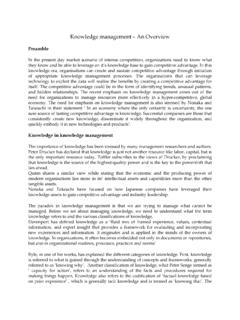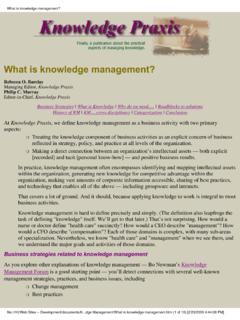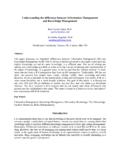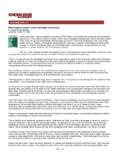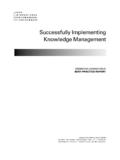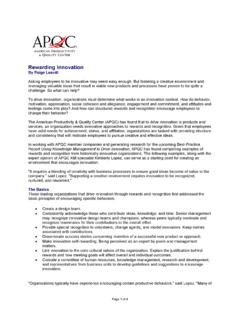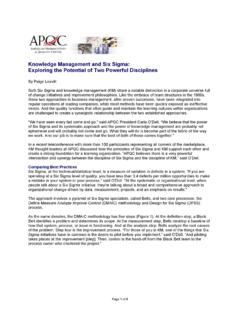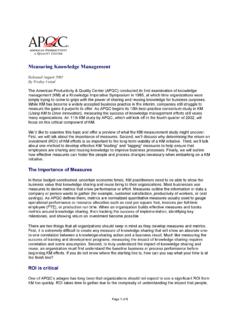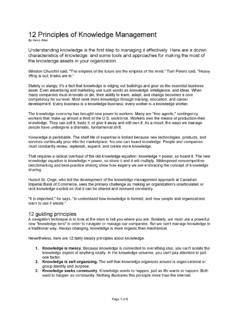Transcription of Applying Knowledge Management to Oil and Gas …
1 Applying Knowledge Management to Oil and Gas Industry challenges Released October 2002 By Paige Leavitt (with contributions from Cynthia Raybourn and Cindy Hubert) The oil and gas industry has taken advantage of Knowledge Management (KM) developments for more than a decade. In that time, the industry has experienced rapid changes and so many mergers that a one-worded petroleum company name now seems like an oddity. Throughout the rapid advance of technology, an extension of offshore drilling, numerous acquisitions, the growing reliance on foreign oil sources, and a focus on environmental issues, KM initiatives have played a part in making operations more efficient and effective. For instance, when oil and gas companies have been faced with new technology, outsourcing, new partnerships, and government regulation, their KM teams have provided support through technology and Knowledge transfer, as well as asset Management . When business issues involved capacity Management , cost reduction, and the environment, KM played a part through forecasting/scheduling and process and technique innovation.
2 And to improve speed and convenience, KM initiatives have expanded to address point-of-sale technology adoption and procedure effectiveness. Undeniably, KM has been proven to increase stock market valuation, assist in growth through acquisition, lead to better-developed products, and encourage intelligent leadership for tenacious early adopters. Chevron's (now ChevronTexaco's) definition of KM is apt for much of the industry: processes, tools, and behaviors that deliver the right content to the right people at the right time, and in the right context so they can make the best decisions, exploit business opportunities, and promote innovative ideas. Industry leaders, many of now merged companies, have embraced KM: "We learned that we could use Knowledge to drive learning and improvement in our company. We emphasize shopping for Knowledge outside our organization rather than trying to invent everything ourselves. Every day that a better idea goes unused is a lost opportunity.
3 We have to share more, and we have to share faster." - Ken Derr, Chevron "All companies face a common challenge: using Knowledge more effectively than their competitors do." - John Browne, BP Amoco " Knowledge Management is the framework for innovation to succeed in the new business while adapting employees to the rapidly changing operating environment." - Brendan O'Neill, Imperial Chemicals Industries "We got into KM because we had so many projects going on that it was difficult to standardize without limiting creativity.. Through KM, different leaders not only share experience and Knowledge , but go forward to create what I call 'contamination centers' where people infect each other with ideas." - Rudulfo Prieto, PDVSA "We must become experts in capturing Knowledge , integrating and preserving it, and then making what has been learned quickly and easily available to anyone who will be involved in the next business decision." - Baird, Schlumberger After so many years of experience, Knowledge Management may not be a novel concept.
4 But an existing KM infrastructure can be a cost-effective means of addressing new and/or increasingly pertinent operational issues in the oil and gas industry, including retaining valuable Knowledge during a period of Page 1 of 6 work force aging/diminishing and increasing efficiency through communities of practice. Furthermore, many companies are fine-tuning their best practices transfer process using content Management systems and communities of practice to further minimize downtime at field sites across the globe. Shifting Work Force and Preventing Corporate Amnesia In addition to numerous mergers and acquisitions, the industry has recently undergone significant turnover, internal redeployments, and growth-then-contraction fluctuations. All of this occurring in an industry in which an aging work force poses a threat to Knowledge retention. The Society for Petroleum Engineers (SPE) estimates that between 1980 and 1998 the number of people working in the oil and gas industry fell from about 700,000 to 300,000 people.
5 The median age of today's SPE members is 47. The industry will experience a 44 percent attrition rate among petroleum engineers by 2010, and 231,000 years of cumulative experience and Knowledge will be lost to the industry in the next 10 years due to retirement. Almost half of the work force will be new. Collectively, upstream oil and gas companies will likely lose more than 60 percent of all employees-along with their experience and Knowledge -by 2010 (Sapient Corporation. Brain Drain: Retaining Intellectual Capital in the Energy Industry. 2001). Through its recent KM consortium benchmarking study, APQC found that the best way to retain valuable Knowledge in the face of attrition or downsizing is to build and sustain systemic KM approaches. Many best-practice organizations embed their Knowledge retention efforts in their overall KM strategy through: identifying and mapping the at-risk Knowledge loss, evaluating the risk, interviewing executives, employees or subject matter experts, conducting project reviews and After-Action Reviews, and establishing communities of practice.
6 The most effective way to combat tomorrow's Knowledge loss is to capture, retain, and transfer valuable Knowledge in today's process and work flow, according to APQC's 2002 Best-Practice Report Retaining Valuable Knowledge : Proactive Strategies to Deal with a Shifting Work Force. This not only retains the context, but also links the sources and co-creators of Knowledge while they are still present to learn from each other. Best-practice organizations often work closely with HR to design and implement Knowledge retention strategies, including hiring employees who will work effectively in a Knowledge -sharing environment. PanCanadian Petroleum Limited, a best-practice partner in APQC's 2001 study Succession Management : Identifying and Cultivating Tomorrow's Leaders, prepared to retain Knowledge using its HR programs. The general managers of business units or centers of excellence were responsible for their respective units and identified trends and future directions, development requirements and follow-up to make sure they occur, and continuity in succession planning and work force Management (forecasting).
7 IT also had a risk mitigation plan that managed talent discontinuity. Consequently, leaders knew where needs would arise before Knowledge retention became a problem. Minimizing Downtime The cornerstone of Knowledge Management is sharing best practices and lessons learned. Companies like Chevron Texaco, Schlumberger, and ExxonMobil have improved their efficiency by institutionalizing a Knowledge -sharing culture. But as these organizations collect large amounts of data, content accessibility and organization become pressing issues. The magnitude of content has increased dramatically, but the time to find and understand it has not. The next step in KM library Management is creating content Management systems to further minimize the time between having a problem/issue and finding a solution/effective approach. Knowledge Management provides context for content Management . Content Management systems of people, processes, and technology provide meaningful and timely information to end users by creating processes that identify, collect, categorize, and refresh content using a common taxonomy across the organization.
8 Content can include databases, audio clips, competitive data, presentations, publications, e-mail virtually any artifact of transactions or dialogue or creative work, Page 2 of 6 inside or outside the organization. Users can access internal and external content from the same system and with the same queries, yet still know the source of the content. The adoption of content Management systems reflects a growing strategic importance of online services and delivery systems within the oil and gas industry. Knowledge Management provides context for content Management by enabling the successful application of the content to today's issues. Schlumberger, a best-practice partner in APQC's 2001 study Managing Content and Knowledge , is a leading example. Knowledge Management and content Management are interrelated at Schlumberger. The company formed the Schlumberger KM group in 1998 to "develop and deploy processes and technology to improve organizational performance and reduce cost for Schlumberger and its customers by enabling individuals to capture, share, and apply their overall Knowledge in real time.
9 " The primary impetus for Schlumberger's content Management business case was that employees needed access to online information in order to more effectively perform their jobs. The company was hosting numerous Web sites, which was confusing to both employees and customers and resulted in redundant and obsolete information, as well as substantial operational overhead. The initial content Management systems were deployed across the enterprise, with approximately 50,000 employees (that number has since increased by more than 25,000) and 600,000 external customers. Schlumberger began the content Management initiative with a small team consisting of five staff members devoted to KM. Schlumberger spent about four years developing its current content Management systems. The initial investment required for the content Management systems at Schlumberger was more than $1 million. Schlumberger factored in the time savings of its employees and the cost savings based on server and other information technology consolidation as part of the business case.
10 Beyond the hard numbers, the investment in content Management was justified because of its substantial increase in service quality to customers, which indirectly leads to revenue enhancement and cost savings in the field. Schlumberger currently has three primary content Management initiatives in place 1. The Schlumberger Knowledge Hub ("The Hub") is an intranet and Internet enterprise information portal that provides employees and customers uniform access to information. The initial goal of the Hub was to centralize the many Schlumberger Web sites and provide access to: Knowledge repositories, project Management and collaboration spaces, real-time stock and industry activity, a help desk, and support for multiple internal and external audiences through threaded discussions, community repositories, and collaboration technology. A key feature of the Hub is the seamless view it provides to the end user, whether it is an employee or a customer. All information is stored in one repository, and the portal posts only the appropriate information for each customer type.

